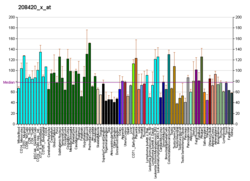| SUPT6H |
|---|
|
| Identifiers |
|---|
| Aliases | SUPT6H, SPT6, SPT6H, emb-5, SPT6 homolog, histone chaperone, SPT6 homolog, histone chaperone and transcription elongation factor |
|---|
| External IDs | OMIM: 601333; MGI: 107726; HomoloGene: 40661; GeneCards: SUPT6H; OMA:SUPT6H - orthologs |
|---|
| Gene location (Human) |
|---|
 | | Chr. | Chromosome 17 (human)[1] |
|---|
| | Band | 17q11.2 | Start | 28,662,198 bp[1] |
|---|
| End | 28,702,679 bp[1] |
|---|
|
| Gene location (Mouse) |
|---|
 | | Chr. | Chromosome 11 (mouse)[2] |
|---|
| | Band | 11 B5|11 46.74 cM | Start | 78,097,572 bp[2] |
|---|
| End | 78,136,813 bp[2] |
|---|
|
| RNA expression pattern |
|---|
| Bgee | | Human | Mouse (ortholog) |
|---|
| Top expressed in | - sural nerve
- epithelium of colon
- stromal cell of endometrium
- gastric mucosa
- anterior pituitary
- skin of leg
- granulocyte
- gastrocnemius muscle
- muscle layer of sigmoid colon
- left adrenal cortex
|
| | Top expressed in | - dentate gyrus of hippocampal formation granule cell
- neural layer of retina
- tail of embryo
- zygote
- primary visual cortex
- yolk sac
- superior frontal gyrus
- genital tubercle
- otic vesicle
- muscle of thigh
|
| | More reference expression data |
|
|---|
| BioGPS | 
 | | More reference expression data |
|
|---|
|
| Gene ontology |
|---|
| Molecular function | - DNA binding
- DNA-binding transcription factor activity
- histone binding
- protein binding
- nucleic acid binding
- nucleosome binding
- RNA binding
| | Cellular component | - nucleus
- nucleoplasm
- transcription elongation factor complex
| | Biological process | - chromatin remodeling
- negative regulation of histone H3-K27 methylation
- mRNA transport
- regulation of transcription, DNA-templated
- regulation of muscle cell differentiation
- regulation of mRNA export from nucleus
- regulation of transcription by RNA polymerase II
- mRNA processing
- regulation of DNA-templated transcription, elongation
- transcription, DNA-templated
- RNA splicing
- regulation of isotype switching
- viral process
- nucleobase-containing compound metabolic process
- positive regulation of transcription elongation from RNA polymerase II promoter
- transcription by RNA polymerase II
- transcription elongation from RNA polymerase II promoter
- nucleosome organization
- mRNA transcription by RNA polymerase II
- regulation of mRNA processing
- transport
- blastocyst formation
| | Sources:Amigo / QuickGO |
|
| Orthologs |
|---|
| Species | Human | Mouse |
|---|
| Entrez | | |
|---|
| Ensembl | | |
|---|
| UniProt | | |
|---|
| RefSeq (mRNA) | | |
|---|
| RefSeq (protein) | | |
|---|
| Location (UCSC) | Chr 17: 28.66 – 28.7 Mb | Chr 11: 78.1 – 78.14 Mb |
|---|
| PubMed search | [3] | [4] |
|---|
|
| Wikidata |
| View/Edit Human | View/Edit Mouse |
|


















